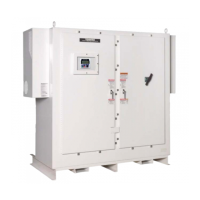HX7+ ASD Quick Start Guide 35
HX7+ Keypad
The HX7+ keypad is comprised of an LCD display, two LEDs, a rotary encoder, and eight keys. These
items are described below and their locations are provided in Figure 21 on pg. 36.
The keypad can be mounted remotely from the ASD as described in the HX7+ ASD Installation and
Operation Manual. The dimensional requirements for remote mounting may also be found in this section.
Using a screw length that exceeds the specified dimensions may cause deformation of the outer surface of
the bezel (see the HX7+ ASD Installation and Operation Manual for specifics on remote mounting).
The interface can operate up to distances of 15 feet from the ASD via the Common Serial (TTL) Port. For
distances beyond 15 feet, the RS232/RS485 port is recommended.
Keypad Features
LCD Display — Displays configuration information, performance data (e.g., motor frequency, bus
voltage, torque, etc.), and diagnostic information.
Local|Remote Key — Toggles the system to and from the Local and Remote modes. The LED is on
when the system is in the Local Command mode. The Local mode allows the Command and Frequency
control functions to be carried out via the keypad.
The Remote mode enables the Command and Frequency control functions to be carried out via the
Terminal Board, CN8 Option (LED Keypad), RS232/RS485, Communication Card, or Pulse Input.
The selection may be made via
Program
Fundamentals
Standard Mode Settings
Command Mode.
The availability of the Local mode of operation (Command and Frequency control) may be disabled via
Program
EOI Option Setups
Local|Remote Key. The availability of the Local mode of operation
may be reinstated by changing this setting or performing a Reset (see F007).
Enter Key — Selects a menu item to be changed or accepts and records the changed data of the selected
field (same as pressing the Rotary Encoder).
Esc Key — Returns to the previous level of the menu tree, toggles between the Panel and the Frequency
Command screens, or cancels changes made to a field if pressed while still in the reverse video mode
(dark background/light text). The three functions are menu-specific.
Run Key — Issues the Run command while in the Local mode.
Run Key Status LED — Illuminates green while stopped or red while running (Red = ALERT!).
Stop Key — Issues the Off command (decelerates to Stop at the programmed rate) if pressed once while
in the Local mode or initiates an Emergency Off (terminates the ASD output and applies the brake if so
configured) if pressed twice quickly from the Local or Remote modes.
Up Key — Increases the value of the selected numerical parameter or scrolls up the menu listing
(continues during press-and-hold).
Down Key — Decreases the value of the selected numerical parameter or scrolls down the menu listing
(continues during press-and-hold).
Rotary Encoder — Functions as the Up key, the Down key, and the Enter key. Turn the Rotary
Encoder either clockwise or counterclockwise to perform the Up or Down key functions. Press the
Rotary Encoder to perform the Enter function. Simultaneously press and turn the Rotary Encoder to
perform a user-defined function (see Program EOI Option Setups Preferences Encoder Action).
cal|Remote
ey

